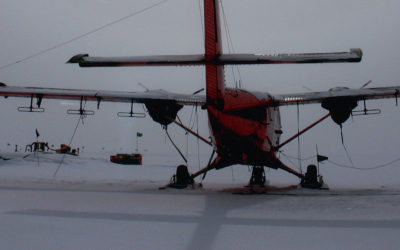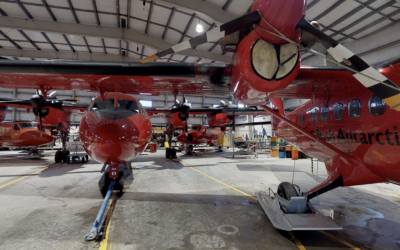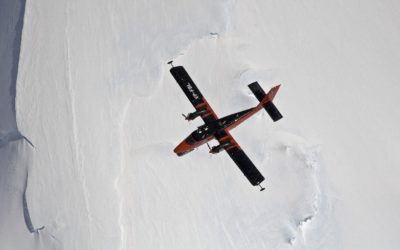Drilling for success
29 January, 2019 by Michael Dinn
In January 2019 a science and engineering team drilled over two kilometres through the ice sheet in West Antarctica using hot water. It was the first time they had done this …
The De Havilland Canada Dash-7 (DHC-7) is a key element of our aircraft capability. This four-engined aircraft with a worldwide reputation for reliability, economy and performance made its first flight to Antarctica in 1994.
The cabin of the Dash-7 is pressurised. Some airlines use the aircraft to transport up to 50 passengers on short-haul routes.
The version operated by BAS has had a variety of technical modifications. These include the fitting of long-range fuel tanks with a fuel jettison system, large cargo door and strengthened cargo floor. It has also been fitted with enhanced avionics and navigation systems. It usually seats 12 to 16 people.
BAS chose the Dash-7 for its rugged design, fuel efficiency and, crucially, short take-off and landing capability. As a result of its large slow-turning propellers, the aircraft is quiet in operation.
During the Antarctic summer the Dash-7 makes regular flights to and from the Falklands. The 1,900km journey can be completed in five hours with up to 16 passengers or 2,000kg of cargo on board.
The introduction of the aircraft as an intercontinental link allows some scientists to make relatively short trips for summer fieldwork, rather than spending the entire season south if they were to travel by ship.
It has also provided a regular link for spares, urgent supplies and fresh food as well as freeing up the two BAS ships, enabling them to spend more time at sea on scientific cruises.
Because the Dash-7 can land on ice runways, it is a regular visitor to the field station at Sky-Blu. Thanks to its greater capacity over the Twin Otters, the Dash-7 has significantly reduced the number of flights required to ferry fuel and supplies.
The aircraft has modifications to allow surveying equipment to be fitted. This includes magnetometer pods on the wingtips enabling the aircraft to be used for aerial studies, remote sensing work or aerial surveying.
29 January, 2019 by Michael Dinn
In January 2019 a science and engineering team drilled over two kilometres through the ice sheet in West Antarctica using hot water. It was the first time they had done this …
11 May, 2023
The 2022/23 Antarctic field season has ended, marking the conclusion of another successful year of scientific exploration in one of the world’s most remote and challenging environments. This field season, …
18 December, 2018
British Antarctic Survey is seeking to purchase a small passenger aircraft to work alongside its de Havilland Canada DHC-7 Series 110 (Dash 7). The aircraft will transport science and support teams and cargo between Rothera Research Station on the Antarctic Peninsula and Punta Arenas, Chile.
11 August, 2017
The British Antarctic Survey Air Unit have been awarded the Johnston Memorial Trophy for 2017 by The Honourable Company of Air Pilots. This is a considerable acknowledgement of the regard held …
20 December, 2013
British Antarctic Survey field season is underway On the eve of the centenary year of Ernest Shackleton’s Endurance Expedition the ship which bears his name is playing a crucial role …
18 October, 2011
Marking the end of the Rothera winter, Rothera had its first visitors since the departure of the Ernest Shackleton in March. On Tuesday a Kenn Borek Air (KBA) Twin Otter …
16 February, 2010
There is a distinctly cosmopolitan feel around British Antarctic Survey’s Rothera Research Station this month (February). Science teams from eight countries enjoyed Rothera’s hospitality as they passed through on their …
8 December, 2009
British Antarctic Survey achieves registration for the International Standard for Business Aircraft Operations British Antarctic Survey (BAS) has achieved registration for the International Standard for Business Aircraft Operations (IS-BAO). Following …
There is no excerpt because this is a protected post.
Wing span: 28.4 metres
Length: 24.5 metres
Take-off weight: 21,320 kg
Engines: 4 x turbo prop
Range: 4,000km (1,500km fully loaded, with required fuel reserves)
Maximum speed: 230 knots


